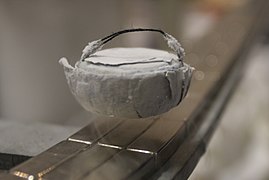అతివాహకత్వము
స్వరూపం

కొన్ని పదార్థాల్లో నిర్దిష్టమైన ఉష్ణోగ్రత వద్ద విద్యుత్ నిరోధం పూర్తిగా తొలగిపోతుంది, అయస్కాంత క్షేత్రం ఉనికిని కోల్పోతుంది. ఈ స్థితినే అతివాహకత్వము (Superconductivity) అంటారు. ఆ పదార్థాలను అతివాహకాలు (Superconductors) అంటారు. సాధారణ లోహ వాహకాలలో ఉష్ణోగ్రత తగ్గే కొద్దీ విద్యున్నిరోధం క్రమంగా తగ్గుతూ వస్తుంది. కానీ అతివాహకాలలో మాత్రం సందిగ్ధ ఉష్ణోగ్రత (Critical temperature) వద్ద ఒక్కసారిగా నిరోధం సున్నా అయిపోతుంది.[1][2] ఇలాంటి స్థితిలో ఒక అతివాహక తీగ వలయంలో విద్యుత్ ని ఒక్కసారి ప్రవేశ పెడితే, మళ్ళీ బయటి మూలంతో ప్రమేయం లేకుండా అలా ప్రసరిస్తూనే ఉంటుంది.[3][4][5][6]
మూలాలు
[మార్చు]- ↑ Combescot, Roland (2022). Superconductivity. Cambridge University Press. pp. 1–2. ISBN 9781108428415.
- ↑ Fossheim, Kristian; Sudboe, Asle (2005). Superconductivity: Physics and Applications. John Wiley and Sons. p. 7. ISBN 9780470026434.
- ↑ Bardeen, John; Cooper, Leon; Schrieffer, J. R. (December 1, 1957). "Theory of Superconductivity". Physical Review. 108 (5): 1175. Bibcode:1957PhRv..108.1175B. doi:10.1103/physrev.108.1175. ISBN 978-0-677-00080-0. S2CID 73661301. Retrieved June 6, 2014. Reprinted in Nikolaĭ Nikolaevich Bogoliubov (1963) The Theory of Superconductivity, Vol. 4, CRC Press, ISBN 0677000804, p. 73.
- ↑ Daintith, John (2009). The Facts on File Dictionary of Physics (in ఇంగ్లీష్) (4th ed.). Infobase Publishing. p. 238. ISBN 978-1-4381-0949-7.
- ↑ Gallop, John C. (1990). SQUIDS, the Josephson Effects and Superconducting Electronics (in ఇంగ్లీష్). CRC Press. pp. 1, 20. ISBN 978-0-7503-0051-3.
- ↑ Durrant, Alan (2000). Quantum Physics of Matter. CRC Press. pp. 102–103. ISBN 978-0-7503-0721-5.
